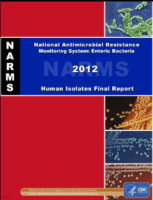NARMS: Good and Bad News for Antibiotic Resistance in Foodborne Germs

The U.S. Centers for Disease Control (CDC) announced today that a new report by the National Antimicrobial Resistance Monitoring System (NARMS) reveals good and bad news regarding antibiotic resistance in foodborne germs. NARMS tracks fluctuations in antibiotic resistance of six types of foodborne germs found in sick humans, retail meats and livestock. Each year, antibiotic resistant infections from foodborne germs cause an estimated 440,000 illnesses in the U.S.
NARMS--a collaborative effort that consists of the CDC, U.S. Food and Drug Administration, U.S. Department of Agriculture, and various state and local health departments--tested more than 5,000 germs from sick persons in 2013 for antibiotic resistance, comparing the results with data from previous years.
On a positive note, NARMS found that multidrug resistance--when a person resists three or more classes of antibiotics--in Salmonella has seen little change, still accounting for 10 percent of foodborne infections. However, some types of Salmonella are seeing more resistance than in the past.
New data shows that in 2013, multidrug resistance in a common Salmonella serotype called I4,[5],12:i:- was 46 percent. This is double the rate that was reported in 2011. Also, resistance in this serotype to four drugs (ampicillin, streptomycin, sulfonamides, and tetracycline) rose from 18 percent in 2011 to 46 percent in 2013. Individuals infected with this particular serotype typically get it from animal exposure, or by consuming certain pork or beef products--likely from live animal markets.
Testing for Campylobacter showed the a quarter of samples taken from sick persons were resistant to quinolones like ciprofloxacin--similar to the rate reported in 2011.
The White House is currently in talks with the food and agriculture industries to curb use of antibiotics in livestock, overuse of which is becoming ineffective--the exact purpose of NARMS’s study.
Looking for a reprint of this article?
From high-res PDFs to custom plaques, order your copy today!




